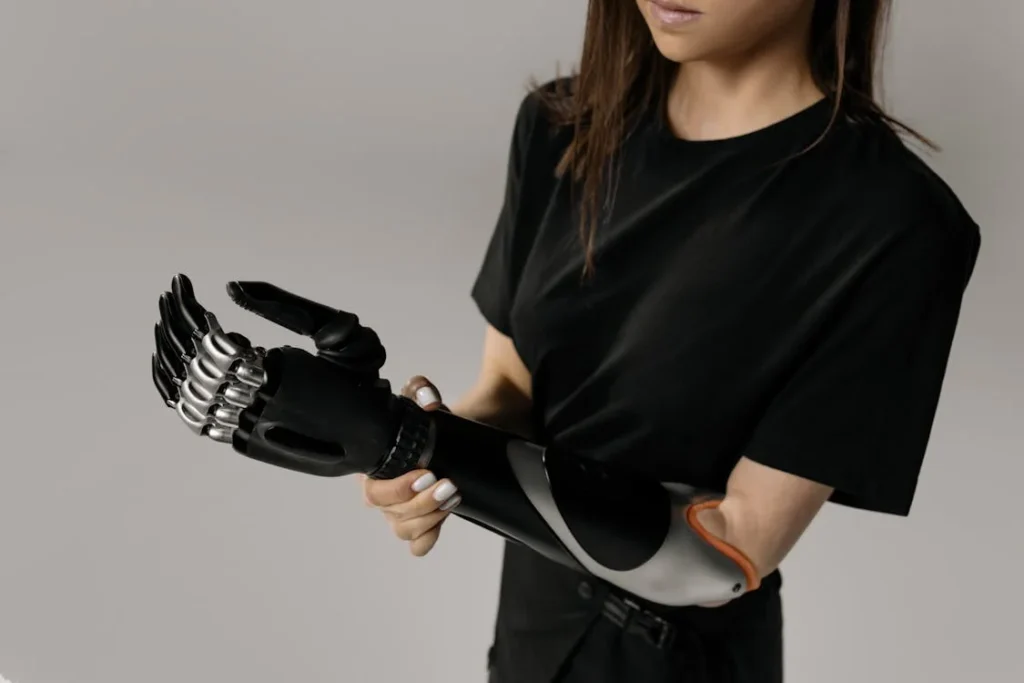A well-fitting prosthetic can transform a person’s life. It allows for smooth movement, reduces discomfort, and ensures that everyday tasks feel as natural as possible. At the heart of a good prosthetic experience is the prosthetic socket—the part of the prosthesis that connects to the residual limb. A poorly fitted socket can cause pain, skin irritation, and even limit mobility, making it crucial to get the right fit.
The key to comfort and mobility lies in understanding how prosthetic sockets work, choosing the right materials, and making necessary adjustments over time. Every limb is unique, and a socket should be tailored to fit an individual’s shape, movement style, and daily activities.
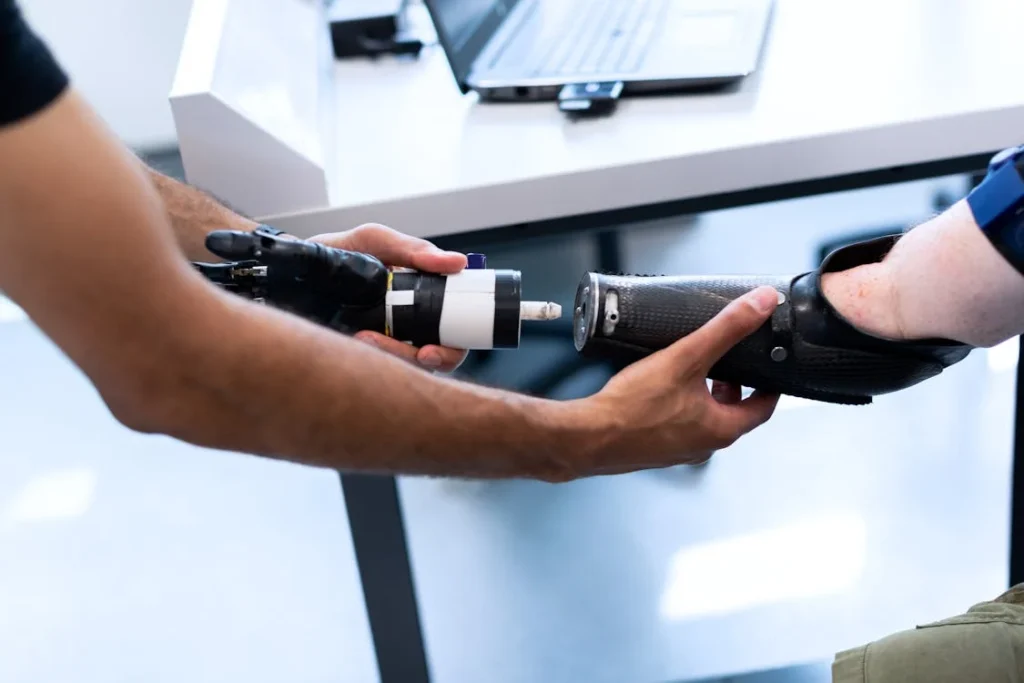
Understanding Prosthetic Sockets and Their Role in Comfort
The prosthetic socket is the most important part of any prosthetic limb. It is the direct connection between the user’s residual limb and the artificial limb, determining how well the prosthetic functions and how comfortable it feels.
A well-fitted socket ensures that the prosthesis feels secure, does not cause pain, and allows for smooth, natural movement.
When the fit is incorrect, it can lead to discomfort, pressure sores, and reduced mobility, making everyday activities much harder.
How Prosthetic Sockets Work
A prosthetic socket is custom-made to match the shape of an individual’s residual limb. Since no two limbs are exactly alike, a good socket should fit snugly while distributing pressure evenly across the limb.
This helps prevent pain and irritation while ensuring that the prosthesis remains stable during movement. The socket also acts as a weight-bearing structure, meaning it must be strong enough to support the user’s body while still being comfortable to wear for long periods.
Sockets are designed to create a secure connection between the limb and the prosthesis without restricting blood flow or causing excessive friction.
Modern socket designs use advanced materials and engineering techniques to achieve a balance between flexibility and support.
Some sockets incorporate gel liners or cushioning materials that help improve comfort by reducing pressure points and absorbing shock.
The Importance of a Proper Fit
An improperly fitted socket can lead to serious problems. If the socket is too loose, the prosthetic limb may shift while walking or performing daily activities, creating instability.
This can lead to discomfort, blisters, and even falls. On the other hand, a socket that is too tight can cause restricted blood flow, skin irritation, and significant pain. It is essential to find the right balance to ensure both comfort and mobility.
A well-fitted socket allows for better control over the prosthesis, making movements feel more natural. When the socket fits correctly, users can walk, grip objects, and engage in daily activities without constantly adjusting their prosthetic limb.
This is especially important for individuals who lead active lifestyles or engage in physical work that requires consistent movement.
Different Types of Prosthetic Sockets
There are several types of prosthetic sockets, each designed for different levels of limb loss and user needs.
The two main categories are upper limb sockets and lower limb sockets, which are further divided based on the specific amputation level and functionality requirements.
For upper limb prosthetics, the socket design depends on whether the user has a below-elbow or above-elbow amputation.
Below-elbow sockets are designed to allow for full forearm movement, while above-elbow sockets need to accommodate elbow articulation.
Many modern upper limb sockets incorporate myoelectric control systems, which use muscle signals to control the prosthetic hand, requiring an even more precise fit to ensure optimal function.
Lower limb sockets must provide strong weight-bearing support while still allowing for flexibility. For individuals with below-knee amputations, the socket is designed to hold the residual limb firmly in place while permitting natural knee movement.
Above-knee sockets, on the other hand, must also provide stability for the prosthetic knee joint, requiring a carefully shaped inner design to prevent pressure points and enhance mobility.
The material and structure of the socket also play a role in comfort. Some sockets are made from carbon fiber, which is lightweight yet strong, while others use thermoplastics that can be adjusted over time as the residual limb changes shape.
Gel liners and soft inner layers improve comfort, making it easier to wear the prosthetic for extended periods.
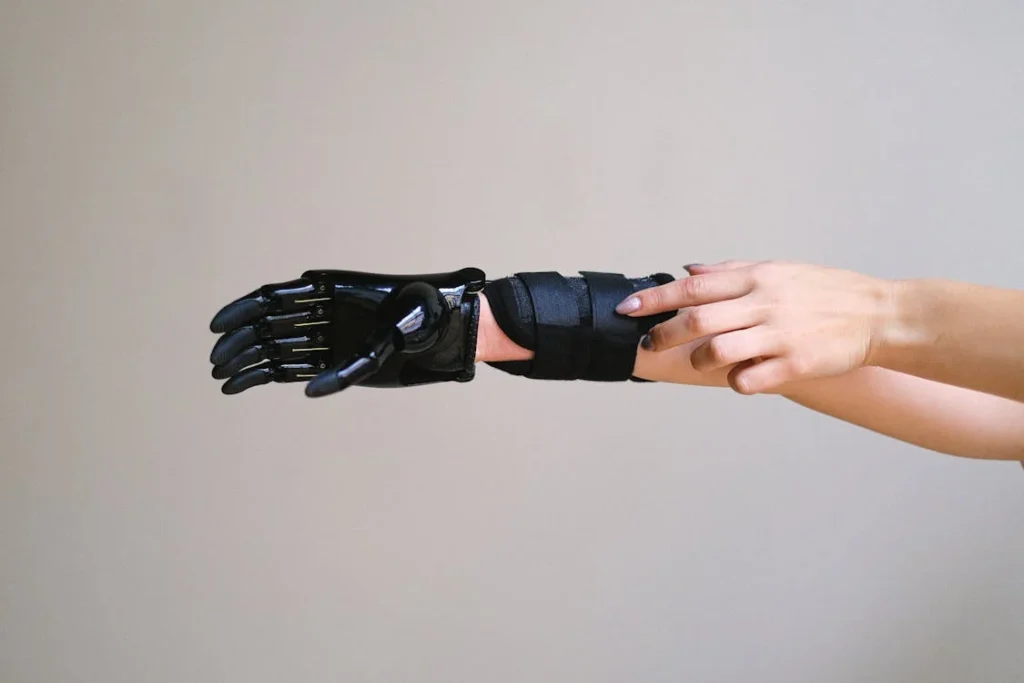
Ensuring the Perfect Fit: The Science Behind Socket Fitment
A well-fitting socket is not just about comfort—it directly impacts mobility, posture, and long-term health. Prosthetic socket fitment is a precise process that requires expertise, customization, and ongoing adjustments.
Since every residual limb is different, a one-size-fits-all approach does not work. The right fit is achieved by carefully analyzing the user’s limb shape, movement patterns, and daily activities.
The Socket Fitting Process
The process of creating a socket begins with a detailed assessment of the residual limb. A prosthetist examines bone structure, muscle tone, skin condition, and sensitivity levels to determine the best type of socket.
Since residual limbs change over time due to muscle loss or growth, the socket must be designed to accommodate these changes while maintaining a secure fit.
A mold or digital scan of the residual limb is used to create a custom socket shape. Traditional methods involve using plaster molds, but modern prosthetics now utilize 3D scanning and CAD (Computer-Aided Design) technology, which provides higher accuracy and a better fit.
The data is used to manufacture the socket, ensuring it follows the natural contours of the limb while distributing pressure evenly.
Once the initial socket is created, a test socket is fitted before the final version is made. This allows users to try it out and provide feedback.
Adjustments are made based on pressure points, alignment issues, and overall comfort. This step is essential because even minor discomfort can lead to irritation, sores, and difficulty in movement over time.
How to Know if Your Socket Fits Correctly
A well-fitting socket should feel snug but not restrictive. The residual limb should not slide inside the socket, and there should be no excessive pressure on any single area.
If a user feels constant discomfort, pinching, or pain, the socket needs adjustment. Proper alignment ensures that weight is distributed evenly, preventing unnecessary strain on the rest of the body.
One of the best indicators of a good fit is stability while walking or using the prosthetic hand. If the limb feels loose, wobbly, or unstable, it can affect balance and increase the risk of falls or repetitive strain injuries.
A properly fitted socket provides a secure yet comfortable hold, allowing for natural movement without excessive effort.
Changes in residual limb volume can also affect fit. Over time, muscle loss, swelling, or weight changes may cause the socket to become too tight or too loose. Many modern sockets feature adjustable components that allow for minor modifications without requiring a completely new fit.
The Role of Suspension Systems in Fitment
A suspension system ensures that the prosthetic limb stays attached securely to the residual limb. There are several types of suspension systems, and the choice depends on the user’s comfort and mobility needs.
Vacuum suspension systems create a strong seal between the limb and the socket using suction, providing a close and comfortable fit.
This reduces movement inside the socket, preventing friction and irritation. Pin-lock and strap systems use mechanical locks to hold the prosthetic in place, offering stability while allowing for easy removal.
Gel liners improve comfort by cushioning the residual limb and reducing impact.
Since each suspension method affects comfort differently, it is important to choose one that matches the user’s lifestyle. A secure fit ensures better movement control, reducing strain on other parts of the body and making prosthetic use more natural.
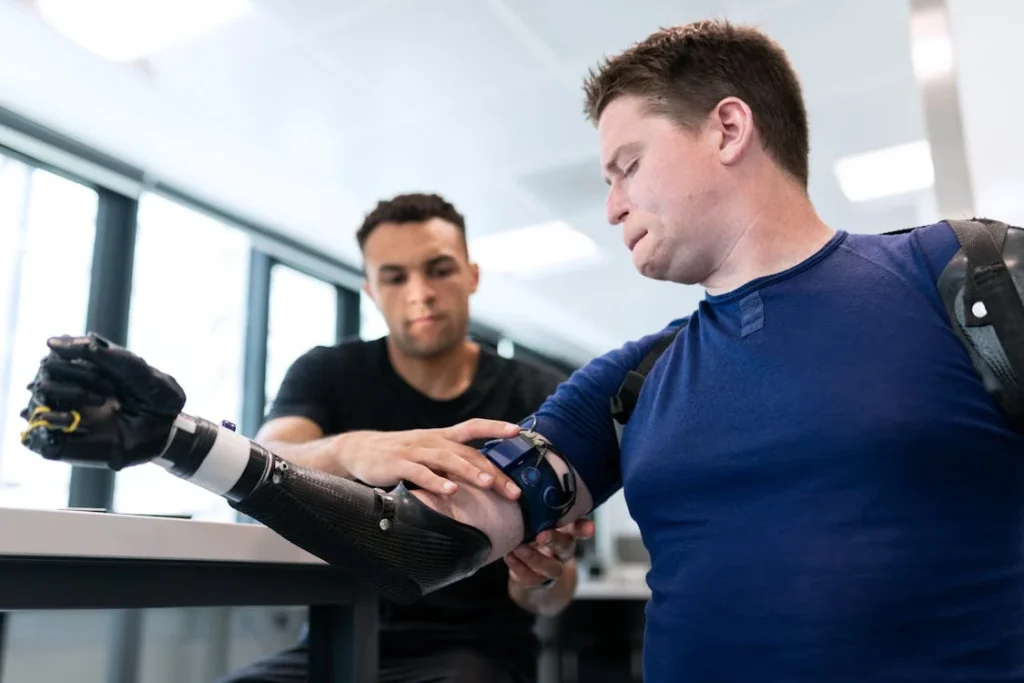
Common Socket Fit Issues and How to Address Them
Even with a custom-fitted prosthetic socket, fit issues can arise over time. Changes in the residual limb, improper alignment, or prolonged use can lead to discomfort, reduced mobility, and skin problems.
Recognizing these issues early and making adjustments can prevent long-term complications and ensure continued comfort.
Pain and Pressure Points
One of the most common complaints with prosthetic sockets is pain caused by pressure points. If certain areas of the residual limb bear more weight than others, it can result in discomfort, bruising, and even sores.
This often happens when the socket is not distributing pressure evenly or if the suspension system is not holding the limb securely in place.
To resolve this, adjustments in the socket’s shape, padding, or liner can help redistribute pressure and improve overall comfort.
Many modern sockets come with gel liners or soft inner layers that help reduce direct pressure on sensitive areas. If pain persists, consulting a prosthetist for a modification or refitting is essential.
Loose or Unstable Fit
A socket that feels too loose can cause instability, making walking or using the prosthetic hand difficult. This problem is often caused by changes in residual limb volume, which can happen due to weight loss, muscle atrophy, or swelling.
A loose fit can lead to excessive movement inside the socket, causing friction that results in skin irritation and blisters.
Adding socket inserts or adjustable liners can help compensate for minor changes in limb size. However, if the fit has changed significantly, a new socket may be necessary.
Some advanced prosthetic systems include adjustable suspension mechanisms that allow for quick tightening or loosening to adapt to daily fluctuations in limb size.
Excessive Sweating and Skin Irritation
Many prosthetic users experience heat buildup and sweating inside the socket, especially in warm climates or during physical activities.
This can lead to discomfort, bacterial growth, and skin irritation. Moisture trapped inside the socket can also affect the fit, making it feel slippery or unstable.
To address this issue, breathable liners and moisture-wicking materials help keep the skin dry. Some modern prosthetic systems use vacuum suspension, which improves airflow and reduces heat buildup inside the socket.
Regular cleaning of the socket and liner is also important to prevent skin infections.
Restricted Circulation or Numbness
A socket that is too tight can restrict blood flow, leading to numbness, tingling, or cold sensations in the residual limb. This often happens when the socket design does not accommodate changes in limb shape or when weight distribution is uneven.
If circulation problems occur, adjusting the fit and alignment of the socket can relieve pressure on sensitive areas. Using softer liners or flexible materials in tight spots can also help.
If numbness persists, switching to a socket with a more dynamic fit—such as one that adapts to limb changes—may be necessary.
Misalignment and Postural Issues
A poorly fitted socket can affect posture and alignment, leading to discomfort in other parts of the body. Users may experience back pain, hip discomfort, or uneven gait if the prosthetic limb is not positioned correctly.
This is particularly common in lower limb prosthetics, where incorrect alignment can place excessive strain on the remaining limb and spine.
Regular follow-ups with a prosthetist help identify alignment issues and make necessary corrections.
Adjustments in the socket’s angle, suspension system, or weight distribution can restore balance, ensuring a more natural posture and reducing strain on the body.
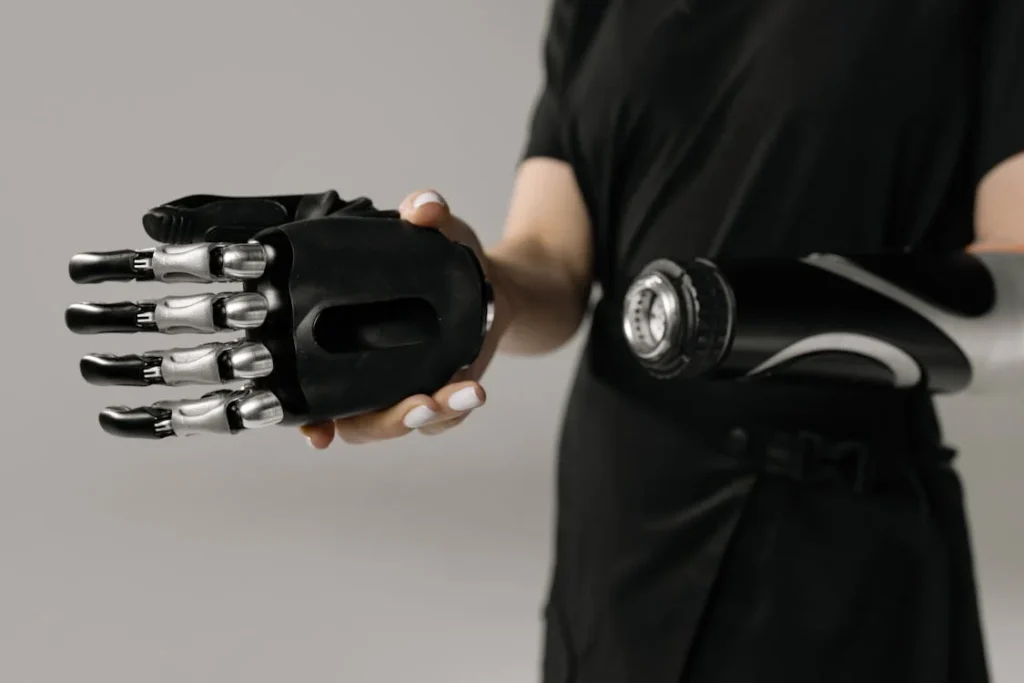
Maximizing Comfort and Mobility with the Right Socket Design
The design of a prosthetic socket plays a crucial role in ensuring both comfort and mobility. A well-constructed socket allows for smooth movement, minimizes strain on the body, and enhances the overall prosthetic experience.
The key to achieving this balance lies in selecting the right materials, integrating modern technology, and making adjustments as needed.
The Role of Materials in Socket Comfort
The choice of materials in a prosthetic socket affects how it feels against the skin, how much flexibility it provides, and how durable it is over time.
Traditionally, sockets were made from rigid materials like plastic or fiberglass, which provided strong support but could feel stiff and uncomfortable.
Today, advancements in prosthetic technology have introduced lighter, more flexible materials that offer both strength and comfort.
Carbon fiber composites are widely used due to their lightweight nature and high durability. These materials provide strong support while reducing the overall weight of the prosthetic limb, making it easier to wear for long periods.
Thermoplastics are another common option, offering flexibility that allows the socket to conform to slight changes in the residual limb’s shape.
Some modern sockets incorporate silicone or gel liners that cushion the limb and reduce pressure points, making movement smoother and more comfortable.
The Impact of Socket Shape on Mobility
The way a socket is shaped directly affects how a prosthetic limb functions. A poorly shaped socket can limit movement, cause discomfort, and affect overall stability.
For lower limb prosthetics, an improper socket design can result in an unnatural walking pattern, leading to strain on the hips and back.
For upper limb prosthetics, poor shaping can restrict the range of motion, making it difficult to perform daily activities like gripping or lifting objects.
Socket design must balance stability and flexibility. Some users require a more rigid fit for strong weight-bearing support, while others need a socket that allows for a greater range of motion.
For instance, individuals with a highly active lifestyle may benefit from a dynamic socket design that moves with their residual limb, reducing restriction and improving comfort during movement.
The shape of the socket also affects weight distribution. A well-designed socket ensures that the user’s weight is evenly spread across the residual limb, preventing excessive pressure on any single point.
This is especially important for above-knee and below-knee prosthetics, where an uneven weight distribution can cause discomfort and instability while walking.
Advancements in Adjustable Sockets
One of the latest innovations in prosthetic socket technology is the development of adjustable sockets. These sockets are designed to adapt to changes in the residual limb’s size and shape, offering a more personalized fit.
Since limb volume fluctuates due to factors like weight change, muscle growth, or swelling, an adjustable socket prevents discomfort and the need for frequent replacements.
Some adjustable sockets use air bladders or mechanical tightening systems that allow users to fine-tune the fit throughout the day.
This is particularly useful for individuals who experience limb volume fluctuations, ensuring that their prosthetic remains comfortable no matter the circumstances.
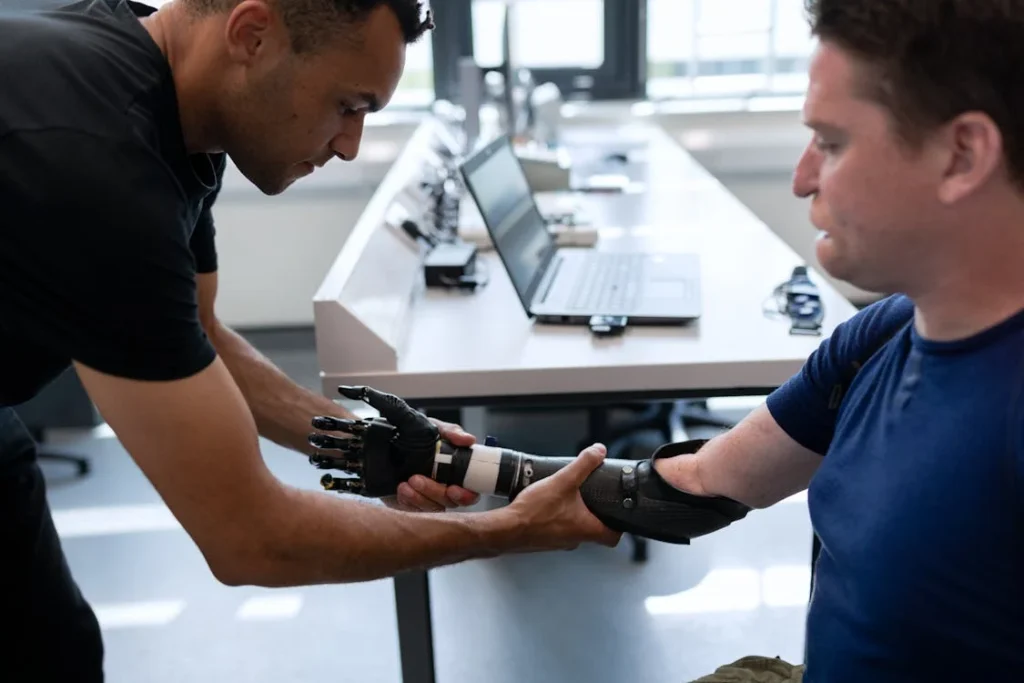
The Importance of Regular Adjustments and Maintenance
Even with a well-designed and properly fitted prosthetic socket, adjustments and maintenance are necessary to ensure long-term comfort and mobility.
Over time, the residual limb changes shape due to muscle atrophy, weight fluctuations, or natural healing processes. These changes can affect how the socket fits, making regular check-ups with a prosthetist essential.
When to Get a Socket Adjustment
A prosthetic socket should feel secure and comfortable, allowing for smooth movement without causing pain or excessive pressure.
However, if a user starts experiencing discomfort, skin irritation, or instability while walking, it may be time for an adjustment. Some signs that a socket needs to be modified include:
- Increased movement inside the socket, leading to friction and blisters.
- Pain or pressure points that make wearing the prosthetic uncomfortable.
- A feeling of looseness or instability, affecting confidence in movement.
- Difficulty with suction or suspension, causing the prosthetic to slip.
These issues can usually be corrected with minor modifications, such as adding padding, adjusting the socket shape, or changing the liner.
More significant fit problems may require a completely new socket, especially if the residual limb has changed significantly over time.
Maintaining Your Prosthetic Socket for Long-Term Use
Proper maintenance extends the lifespan of a prosthetic socket and helps prevent issues before they become serious.
Keeping the socket clean is crucial, as sweat and bacteria can build up, leading to skin infections or unpleasant odors. Cleaning the socket daily with mild soap and warm water helps keep it hygienic.
Liners and suspension systems also require regular inspection. Over time, gel liners can wear down, reducing their cushioning effect and increasing pressure on the residual limb.
Replacing worn-out liners and checking the suspension system for signs of wear ensures that the prosthetic remains functional and comfortable.
Periodic visits to a prosthetist help identify small problems before they lead to pain or restricted movement.
Many prosthetic clinics offer routine check-ups to assess socket fit and make necessary adjustments, ensuring that users can continue living their lives without discomfort or limitations.
How Robobionics Ensures the Perfect Fit
At Robobionics, we understand that a properly fitted socket is the foundation of a great prosthetic experience. That’s why we use advanced 3D scanning, high-quality materials, and customizable socket designs to provide users with the best possible fit.
Our team of experts ensures that every socket is tailored to the user’s needs, providing long-term comfort and mobility.
If you or a loved one is experiencing discomfort with a prosthetic socket, book a free consultation with us today. We are committed to helping you achieve the best fit so you can move with confidence and ease.

The Psychological Impact of a Well-Fitted Prosthetic Socket
The physical benefits of a properly fitted prosthetic socket are clear—it enhances mobility, reduces discomfort, and allows for natural movement.
However, the psychological impact is just as important. A socket that fits well contributes to confidence, independence, and an overall improved quality of life.
When a prosthetic is uncomfortable or causes pain, it can lead to frustration, discouragement, and even avoidance of activities that once brought joy.
Building Confidence Through Comfort
A prosthetic should feel like an extension of the body. When the socket fits well, users are more likely to wear their prosthesis for longer periods, engage in social activities, and move freely without hesitation.
The ability to perform daily tasks with ease—whether it’s shaking hands, walking comfortably, or holding a coffee cup—instills confidence and a sense of normalcy.
On the other hand, a poor fit can lead to self-consciousness and frustration, making users less inclined to use their prosthetic. If walking feels unstable or if the prosthetic causes pain, the user may avoid social outings, work, or physical activities.
This is why ensuring the right fit is not just about comfort—it’s about allowing users to fully participate in life without limitations.
Reducing Fatigue and Mental Strain
A well-fitted socket reduces mental and physical exhaustion. If a prosthetic does not fit properly, users often compensate by adjusting their gait, posture, or grip, leading to muscle fatigue and unnecessary strain on the rest of the body.
This can cause back pain, hip discomfort, or even headaches, making movement feel like a constant effort. When the socket fits well, movement becomes effortless. The prosthetic feels secure, requiring less mental focus to control it.
This allows users to focus on their activities rather than on the prosthetic itself, reducing stress and improving overall well-being.
Encouraging Long-Term Prosthetic Use
Many individuals who experience discomfort with their socket stop wearing their prosthetic altogether. This can lead to muscle weakness in the residual limb and an increased reliance on assistive devices or caregivers. Over time, avoiding prosthetic use can make it harder to return to an active lifestyle.
Ensuring a proper fit from the start helps users develop a positive relationship with their prosthetic. When the socket feels comfortable, users are more likely to wear it consistently, allowing them to regain independence and improve their physical health.
Personalized Solutions for Maximum Comfort
At Robobionics, we understand that each user’s experience is unique. That’s why we focus on custom-fit solutions, advanced socket technology, and ongoing support to ensure long-term comfort.
Our team works closely with users to make adjustments as needed, ensuring that their prosthetic fits their lifestyle, activity level, and mobility needs.
If you’re experiencing discomfort with your current prosthetic or are looking for a custom-fit solution, book a consultation with Robobionics today. Let us help you achieve a fit that enhances both your mobility and your confidence.
Conclusion
A well-fitted prosthetic socket is the foundation of comfort, mobility, and confidence for prosthetic users. Advances in 3D scanning, adjustable sockets, and vacuum-assisted suspension are transforming the way sockets are designed, ensuring a better fit, greater stability, and reduced discomfort. When a socket is properly fitted, movement feels natural, fatigue is minimized, and daily activities become easier.
The right socket enhances not just physical comfort but also mental well-being. A poorly fitted prosthetic can lead to frustration, while a comfortable one encourages long-term use, independence, and an active lifestyle. Regular adjustments, proper maintenance, and high-quality materials play a key role in ensuring that the prosthetic remains comfortable over time.
At Robobionics, we specialize in custom-fit solutions that maximize comfort and mobility. Our innovative approach ensures that each socket is tailored to the user’s unique needs. If you’re experiencing discomfort with your prosthetic or need a new fit, book a consultation with us today and take the next step toward better mobility and confidence.



